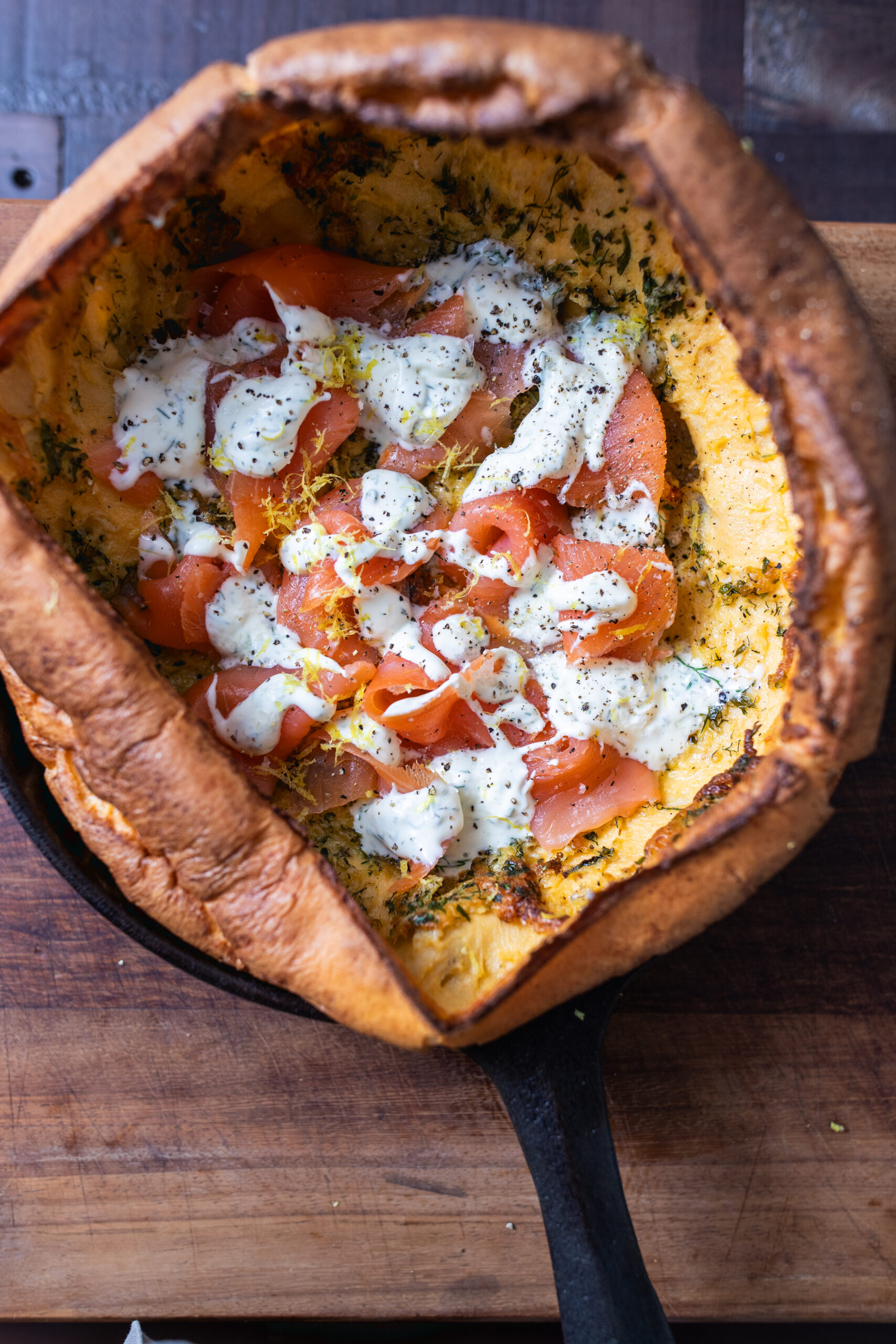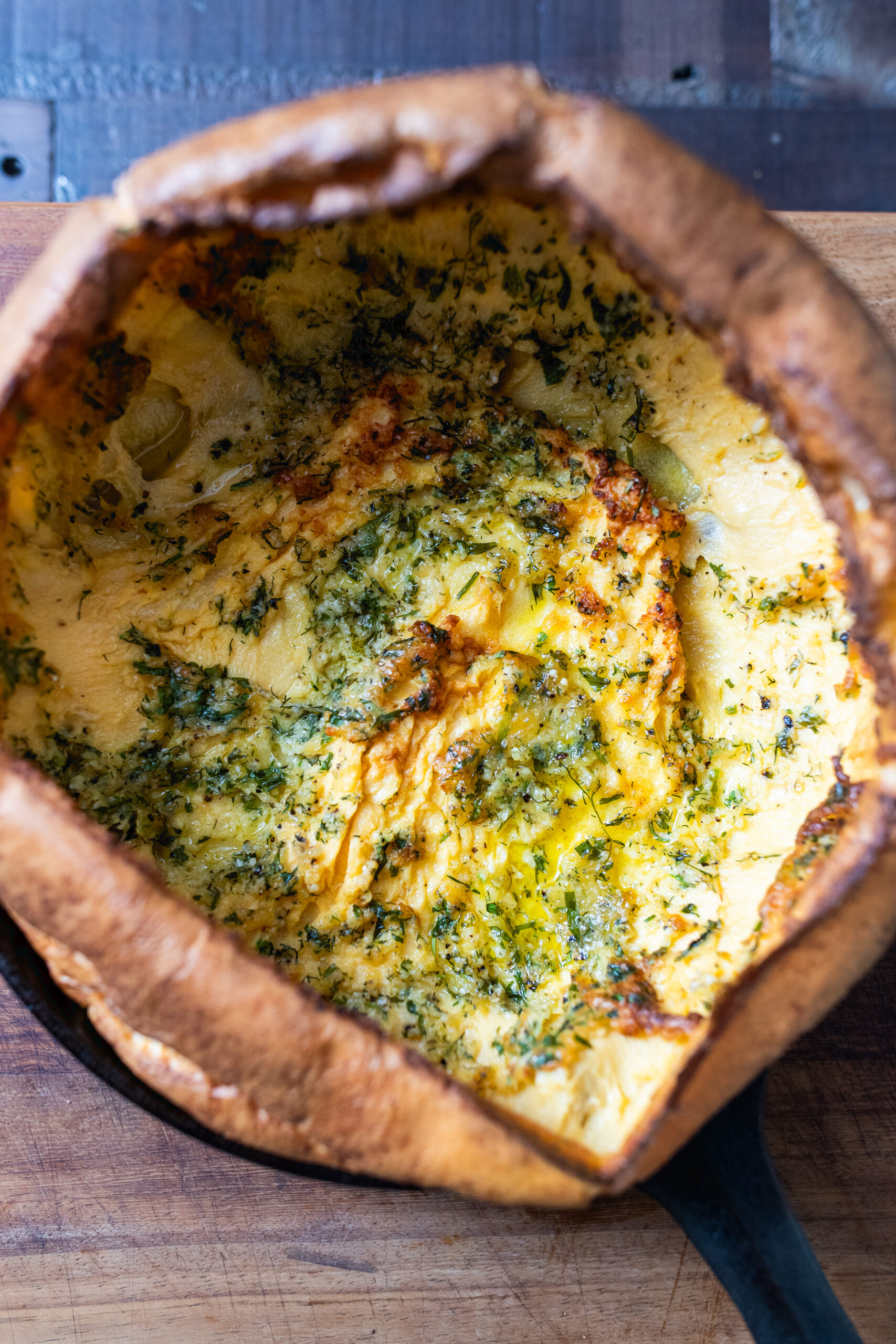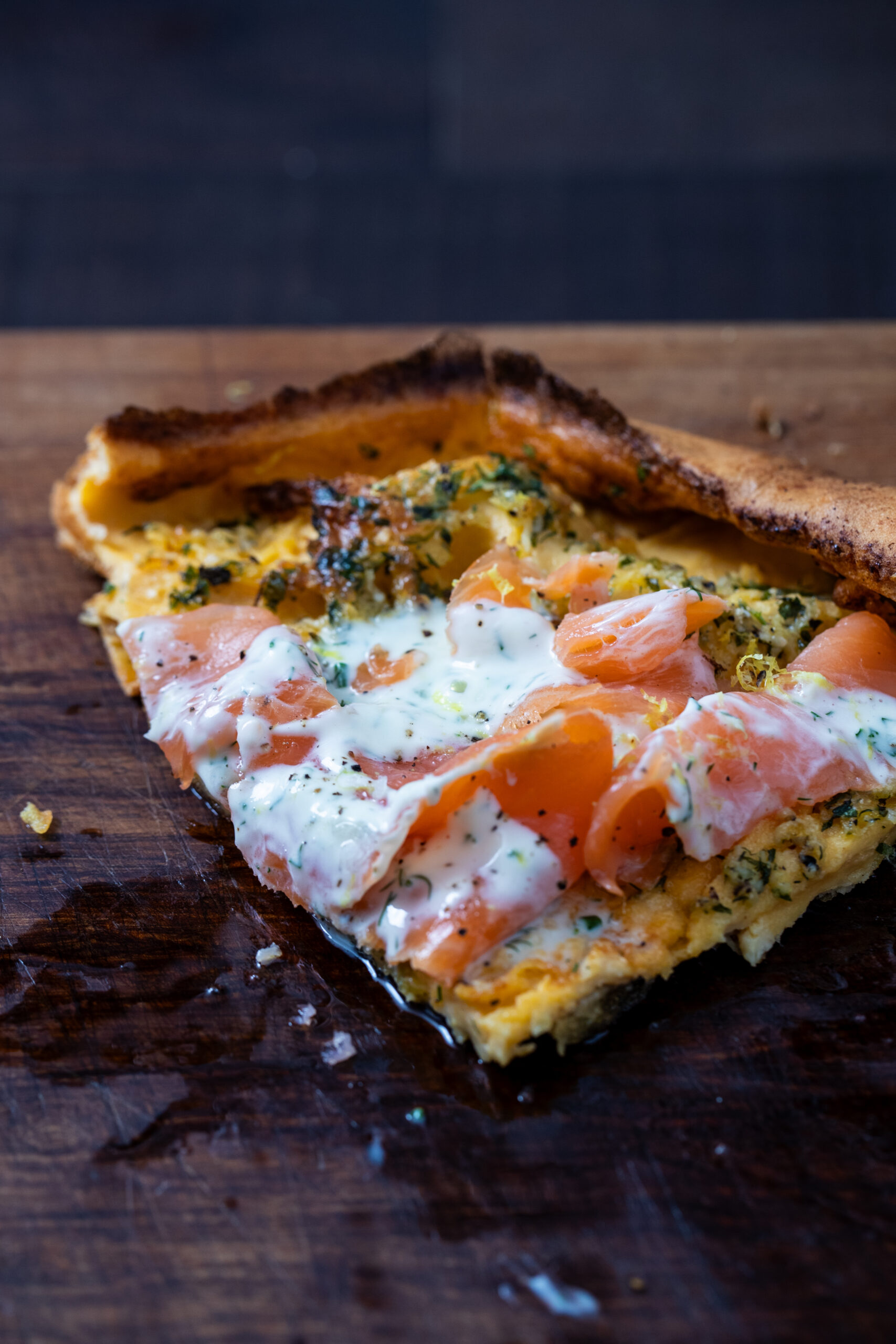If you’re looking for the recipe for my viral smoked salmon savoury dutch baby, here it is.
In my video I suggested it be your Christmas morning breakfast.
I really think it’s ideal for that. This recipe will make enough for a breakfast of four people. It’ll still leave room for Christmas Day lunch and a few chocolates too!

If you’re finding this at a different time of year, it’s perfect for a weekend brunch. I’d have half the recipe for a lunch or dinner too!
Savoury Dutch babies, often overshadowed by their sweet counterparts, are a fantastic way to start your day with a wholesome twist. Imagine a dish that combines the fluffy texture of a popover with the heartiness of your favourite savoury breakfast ingredients.
It’s a versatile recipe that can adapt to whatever you have in your fridge (after all, I’m making an entire series of videos about it). Someone in my comments mentioned they were starting to see just how versatile these can be.
So, whether you’re a seasoned Dutch baby aficionado and have never tried the savoury version, or new to this delightful dish, let’s dive into the art of making savoury Dutch babies.
What is a Dutch Baby Made Of?
At its core, a Dutch baby is a marvel of culinary simplicity, requiring only a handful of basic ingredients you likely already have in your kitchen. A typical savory Dutch baby is made from:
- Eggs: The backbone of the dish, providing structure and a rich flavor.
- Milk: For a smooth and creamy texture.
- Flour: Just enough to give it body without becoming too heavy.
- Salt: A pinch to enhance all the flavors.
- Butter: For that irresistible golden crust (I add this to the pan rather than to the batter)
Unlike its sweet cousin, which often welcomes sugar and vanilla, the savoury version invites a world of spices, cheese, and herbs. You might add a dash of black pepper, a sprinkle of grated Parmesan, or a handful of fresh chives to the batter. The beauty lies in its versatility – you can experiment with different ingredients based on your dietary preferences and what you have on hand.
From a health perspective, the savory Dutch baby can be a nutritious choice, especially when you opt for whole wheat flour or incorporate additional protein and vegetables. Imagine a fluffy, eggy base topped with spinach, tomatoes, and a bit of feta cheese for a Mediterranean twist, or maybe some smoked salmon and dill for a touch of elegance.
The simplicity of a savoury Dutch baby doesn’t just lie in its ingredients but also in its preparation. It’s a blend, pour, and bake affair – minimal fuss with maximum flavour payoff.
It’s a testament to the fact that healthy cooking doesn’t have to be complicated or time-consuming. A savoury Dutch baby proves that with just a few wholesome ingredients, you can create a meal that is as nourishing as it is delicious.

The Unique Charm of Dutch Babies: Not Your Average Pancake
When you think of a Dutch baby, you might initially picture something akin to a pancake. However, while they share some basic ingredients, the Dutch baby is a unique culinary creation with its own distinct character.
Texture: The Showstopper Difference
The most striking difference lies in the texture. Pancakes are known for their classic, slightly fluffy consistency, achieved through a batter that’s gently mixed and cooked on a griddle or pan. In contrast, a Dutch baby has a wonderfully dramatic rise, creating a dish that’s amazingly crispy on the edges yet tender and custard-like in the middle. This texture is a result of a thinner, more liquid batter that’s poured into a hot skillet and baked in a high-temperature oven. The result? A puffy, golden delight that’s a visual and textural delight.
Taste: Subtle yet Distinct
Flavour-wise, Dutch babies offer a more eggy and buttery taste compared to pancakes. While pancakes often serve as a canvas for sweet toppings like syrup or fruit, the savoury Dutch baby shines with its own inherent flavours. The eggs and butter create a rich base, which can be enhanced with ingredients like cheese, herbs, and spices, offering a more sophisticated and nuanced taste profile.
Versatility in Serving
Another notable difference is how they’re served. Pancakes are typically stacked and served individually, often drenched in syrup or topped with fruit. On the other hand, a Dutch baby is usually baked in one large pan and served family-style, cut into wedges. This communal serving method adds an element of casual elegance and makes it an ideal dish for gatherings (including family gatherings on Christmas morning).
In essence, while a Dutch baby may share some pancake DNA, it stands apart as a unique and versatile dish. Its dramatic rise, custardy texture, and rich flavour make it a special treat for any meal – a delightful variation that challenges the norms of traditional pancake breakfasts.

Tackling the Eggy Taste: Perfecting Your Dutch Baby
A common query among Dutch baby enthusiasts is about its distinctive eggy taste. While this characteristic is part of the charm for many, others might prefer a more balanced flavor profile. Understanding why your Dutch baby might lean towards an eggy taste and how to fine-tune it is key to perfecting this dish.
Why Does It Taste Eggy?
The eggy taste in a Dutch baby primarily stems from its high egg content. Eggs are essential for creating the Dutch baby’s signature rise and custardy texture. However, when the ratio of eggs to flour and milk is too high, or if the eggs used are particularly large, the resulting flavor can be more omelette-like than desired.
Balancing the Flavors: Tips and Tricks
- Adjust the Egg Ratio: If you find the eggy taste too overpowering, try reducing the number of eggs slightly or increasing the amount of flour and milk proportionally. This adjustment can help in achieving a more balanced flavor.
- Incorporate Aromatic Ingredients: Adding ingredients that complement or offset the egg flavor can make a world of difference. Consider mixing in some finely chopped herbs, like chives, parsley, or dill, which add freshness and depth. A pinch of nutmeg or a dash of paprika can also elevate the overall flavor profile.
- Choose Your Dairy Wisely: The type of milk and butter you use can impact the taste. Using whole milk or a combination of milk and a touch of cream can add richness, reducing the relative eggy flavor. Similarly, using high-quality, flavorful butter can make the dish more savory and less egg-forward.
- Experiment with Cheeses: Cheese can be a game-changer in a savory Dutch baby. A sharp cheddar, nutty Gruyère, or even a bit of tangy goat cheese can add layers of flavor, beautifully balancing the egginess.
- Top It Off: The toppings you choose can also help in masking an overly eggy taste. Savoury toppings like sautéed mushrooms, caramelised onions, or roasted vegetables add complexity to the flavour and can make the eggy base seem more like a complementary backdrop rather than the main act.
By understanding the reasons behind the eggy taste and experimenting with these tips, you can tailor your Dutch baby to suit your palate perfectly. Remember, cooking is an art, and the Dutch baby is your canvas – feel free to get creative and adjust until you find your ideal balance!

Dutch Baby vs Yorkshire Pudding: A Culinary Comparison
While both Dutch baby and Yorkshire pudding are beloved for their delightful puffiness and oven-baked goodness, they are distinct dishes with unique origins and cooking methods. Let’s delve into the differences and similarities between these two culinary classics.
Origins: A Tale of Two Countries
The Dutch baby, despite its name, has its roots in the United States. It’s believed to have been derived from the German pancake and popularized in Seattle in the early 20th century. The name ‘Dutch’ is actually a misnomer, stemming from a corruption of the word ‘Deutsch’ (German).
Yorkshire pudding, on the other hand, hails from England and dates back to the 18th century. Traditionally served as a first course aimed to fill diners and reduce the consumption of more expensive meats, it has now become a staple of the British Sunday roast.
Ingredients: Simplicity vs. Savoury
Both dishes share simple, staple ingredients: eggs, flour, and milk. However, the ratios differ. A Dutch baby typically has a higher proportion of eggs to flour and milk, leading to a custard-like center. Yorkshire pudding, in contrast, uses more milk and less egg, resulting in a lighter, airy texture.
Cooking Methods: Skillet vs. Tin
The cooking vessel and method are key differentiators. A Dutch baby is baked in a cast-iron skillet, which gives it a dramatic rise and a crispy, golden exterior. The batter is poured into a preheated, butter-coated skillet, creating a sizzling base that helps in forming the characteristic puffy edges.
Yorkshire pudding, meanwhile, is cooked in a muffin tin or a dedicated Yorkshire pudding tin. Each cup is filled with a small amount of oil or beef drippings, and the tin is preheated until the oil is smoking hot before the batter is poured in. This method ensures that each pudding rises tall and has a hollow center, perfect for holding gravy.
Texture and Flavour:
Texture-wise, the Dutch baby is often more dense and eggy, with a pancake-like feel, whereas Yorkshire puddings are light, airy, and crisp. Flavour-wise, Dutch babies are versatile, easily swinging between sweet and savoury, whereas Yorkshire puddings are decidedly savoury, often flavoured by the drippings or oil they’re cooked in.
In summary, while the Dutch baby and Yorkshire pudding share some basic ingredients and a love for the oven’s heat, they diverge in their origins, cooking methods, and final texture and taste. Both, however, stand as delightful examples of how simple ingredients can be transformed into something truly extraordinary.
PrintSmoked Salmon Savoury Dutch Baby
- Total Time: 30 minutes
- Yield: 4 people 1x
Ingredients
Dutch Baby
- 4 eggs
- 180g milk
- 90g plain flour
- 1/4 tsp salt
- 80g butter
- 20g parmesan cheese
- 15g fresh parsley, dill & tarragon
- 1 garlic clove
To serve
- 200g smoked salmon
- 50g crème fraîche
- 2 tsp fresh dill
- 1 tbsp lemon juice
- 1 tsp lemon zest
- 1/4 tsp salt
Instructions
Dutch Baby
-
Preheat your oven to 230°C (445°F) and place your cast iron pan on the middle shelf. Make sure there’s enough space above it for your Dutch Baby to expand.
-
In a stick blender jug add the eggs, flour, milk & salt. Blend until smooth and aerated. This can also be done in a stand up blender.
-
Leave the mixture to stand whilst the oven comes up to temperature. The closer the mix is to room temp, the better rise you’ll get in the finished product.
-
Grate the parmesan, chop the herbs fine and mince the garlic. Transfer to a bowl. I like to add a pinch of salt to this mixture also.
-
When you’re ready to go, remove the pan from the oven and add the butter. Let it bubble and melt down completely. Then pour your batter mix into the pan.
-
Scatter the cheese and herb mix over the top and return to the oven for 15 to 20 minutes. Do not open the oven during this time.
To serve
-
In a bowl mix the crème fraîche, chopped dill, lemon juice, lemon zest and salt.
-
Arrange the smoked salmon in the bottom of the Dutch Baby and spoon over the dill crème fraîche.
Notes
- I use a 25cm (10 inch) pan. Anything around that size will work
- Prep Time: 15 minutes
- Cook Time: 15 minutes
Nutritional Insights and Health Benefits
A savoury Dutch baby isn’t just a treat for the taste buds; it’s also packed with nutritional benefits. Understanding the nutritional breakdown and the health benefits of its ingredients can inspire you to include this dish in your meal rotation.
Nutritional Breakdown of a Typical Savoury Dutch Baby
A basic savoury Dutch baby, consisting of eggs, milk, flour, and butter, offers a balance of protein, carbohydrates, and fats. Eggs, the primary ingredient, are an excellent source of high-quality protein and contain various essential nutrients like vitamin B12, riboflavin, and selenium. Whole milk adds calcium and vitamin D, while flour provides carbohydrates for energy. Butter, used in moderation, contributes to the dish’s richness and flavour while adding some fat-soluble vitamins.
Health Benefits of Ingredients
- Eggs: Known for their nutrient density, eggs contain choline, which is important for brain health, and lutein, which supports eye health.
- Whole Milk: It provides calcium, crucial for bone health, and other nutrients like potassium and vitamin B12.
- Whole Wheat Flour (Alternative to All-Purpose Flour): Offers more fiber and nutrients than white flour, supporting digestive health and providing a slower release of energy.
- Herbs and Vegetables (Toppings): These not only add flavor but also bring in additional vitamins, minerals, and antioxidants.
For specific health claims, it’s important to refer to credible sources. Websites like Harvard Health, Mayo Clinic, and The Nutrition Source provide reliable information on nutrition and health benefits.
Conclusion
The savoury Dutch baby is a testament to how simple, wholesome ingredients can come together to create something both delicious and nourishing. Whether you’re a novice in the kitchen or a seasoned cook, this dish offers endless possibilities for customisation and experimentation.
I encourage you to try this recipe, as well as my others and make them your own. Add your favourite toppings, play with different herbs and spices, and find what works best for you.
Cooking is a personal journey, and I would love to hear about your savoury Dutch baby adventures. Share your experiences, tweaks, and favourite variations in the comments below. Your insights could inspire someone else in their culinary exploration!

Some instructions are missing: what size cast iron do you use? Where does the lemon juice go? How long does the whole thing take?
Thanks, I’ve updated the instructions now.
For quick reference, I use a 25cm (10 inch) pan, the lemon juice goes in the creme fraiche and you can probably do this whole thing in around 30 mins.
First saw this on IG and saved it for later. I’ve now made it 3 times, once for my bf and myself and twice for my family, including Easter brunch – it’s been a hit each time!
Hello. May you please let me know what size skillet these proportions will work best in? Thank you.
I use 25cm (10 inch)
What size cast iron skillet is best? I have a 10 inch and 12 inch, hoping one of those works!
I use 25cm (10 inch)
We saw this Dutch Baby series on instagram and just had to try it! We added 1 tablespoon of dried rosemary and 1 teaspoon garlic powder to the batter and added Parmesan cheese to the top of the batter and cooked it for 15min. Then put prosciutto, Gruyere, arugula and balsamic vinegar top of the cooked dough when it came out of the oven. It was AMAZING. Super easy and very versatile. I am never ordering pizza again! We will just going to make these!!!
Came out perfectly & delicious on the first try! Thank you! Will definitely make this again for friends & family!
Inspired.
I will try this soon…. With my fav toppings. I’m thinking: caramelised onions, blue cheese and pears…
I love a savory Dutch Baby, and your recipe gave me an idea to combine the traditional lox/cream cheese/bagel experience with the classic French fines herbes mixed into a Middle Eastern labane version of cream cheese, and joined with the popular Middle Eastern/Indian flavor of nigella seeds.Idk if it’ll work, but I think my Brooklyn Bébé can embrace the several cultures of America, France, India, and the Middle East. Food can bring us together, and restaurants can end wars! #MakeLunchNotWar